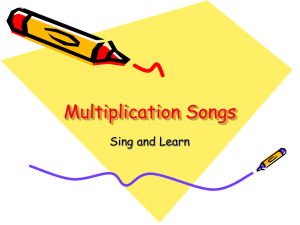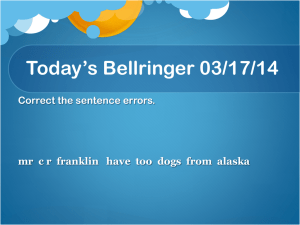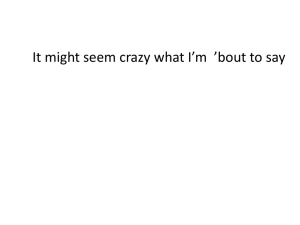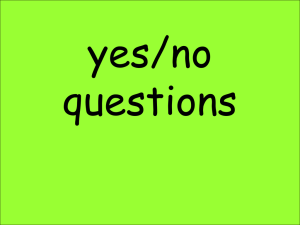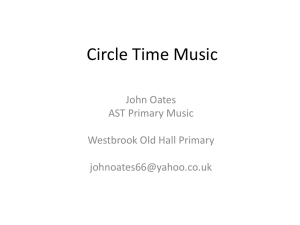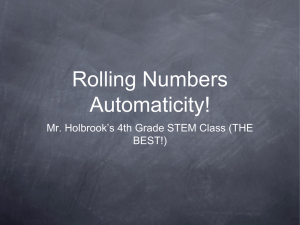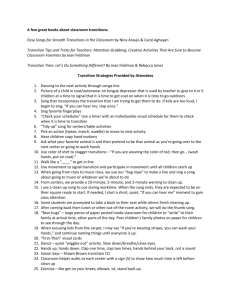Patterns & Algebra - nswcurriculumsupport
advertisement
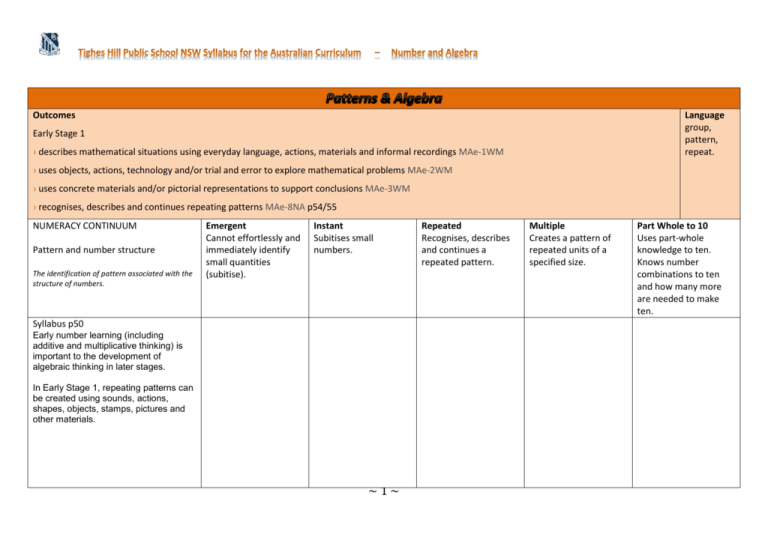
Outcomes Language group, pattern, repeat. Early Stage 1 › describes mathematical situations using everyday language, actions, materials and informal recordings MAe-1WM › uses objects, actions, technology and/or trial and error to explore mathematical problems MAe-2WM › uses concrete materials and/or pictorial representations to support conclusions MAe-3WM › recognises, describes and continues repeating patterns MAe-8NA p54/55 NUMERACY CONTINUUM Pattern and number structure The identification of pattern associated with the structure of numbers. Emergent Cannot effortlessly and immediately identify small quantities (subitise). Instant Subitises small numbers. Syllabus p50 Early number learning (including additive and multiplicative thinking) is important to the development of algebraic thinking in later stages. In Early Stage 1, repeating patterns can be created using sounds, actions, shapes, objects, stamps, pictures and other materials. ~1~ Repeated Recognises, describes and continues a repeated pattern. Multiple Creates a pattern of repeated units of a specified size. Part Whole to 10 Uses part-whole knowledge to ten. Knows number combinations to ten and how many more are needed to make ten. Syllabus, PAES 1.1, NES1.3 Sample units of work P&A pp. 23-26 M&D pp. 20-22 Developing Efficient Numeracy Strategies Stage 1 (DENS 1), pp. 47-49 Talking about Patterns and Algebra, pp. 11-32 What is a pattern?, Talking about Patterns and Algebra, p. 15 Look and say, (DENS 1), pp. 47 Robot race, (DENS 1), p. 48, BLM pp. 68-69 Load the truck, (DENS 1), p. 49, BLM pp. 70-71 Make a pattern, (DENS 1), p. 49 Learning object - Monster choir: making patterns Learning object - Monster choir: missing monsters Learning object - Penguin count Syllabus, PAES1.1, NES1.3 Sample units of work, P&A, pp. 2326 M&D pp. 20-22 Developing Efficient Numeracy Strategies Stage 1 (DENS 1), pp. 122-129 Talking about Patterns and Algebra, pp. 11-32 Find a group, (DENS 1), pp. 122- 123 Trains, (DENS 1), pp. 122123 Mail sort, (DENS 1), pp. 122-123 Learning object - Monster choir: making patterns Learning object - Monster choir: missing monsters Learning object - Penguin count SMART notebook Creating patterns Teaching and Learning Activities Syllabus, PAES1.1, NES1.3 Sample units of work, P&A pp. 23- 26 M&D pp. 20-22 Developing Efficient Numeracy Strategies Stage 1 (DENS 1), pp. 122-129 Talking about Patterns and Algebra, pp. 11-32 Drawing patterns, Talking about Patterns and Algebra, p. 21 Rhythmic counting, (DENS 1), pp. 124-125 Body percussion, (DENS 1), pp. 124-125 Learning Object - Number grid Learning object - Monster choir: making patterns Learning object - Monster choir: missing monsters Learning object - Penguin count SMART notebook – Rhythmic counting SMART notebook – Creating patterns Syllabus, PAS1.1, NS1.3 Sample units of work, P&A pp. 60- 65, M&D pp. 47-51 Developing Efficient Numeracy Strategies Stage 1 (DENS 1), pp. 192-195 pp. 268-273 Talking about Patterns and Algebra, pp. 33-65 Generating number sequences, Talking about Patterns and Algebra, p. 38 Teddy tummies, (DENS 1), pp. 268-269, BLM p. 289 Triangle teddies, (DENS 1), pp. 192-193 Learning object - Number grid Learning object - Monster choir: look and listen Learning object - Penguin count SMART notebook – Creating patterns Notes/ Future Directions/Evaluation EMERGENT Activities INSTANT Activities ‘Is the Same as’ Students are given collections of objects to sort and count in order to find groups that ~2~ Syllabus, NS1.2 Sample units of work, pp. 42-46 Developing Efficient Numeracy Strategies Stage 2 (DENS 2), pp. 4861 Memory of tens, (DENS 2), pp. 52- 53 Number chop, (DENS 2), pp. 58-59 Learning object - Addition wheel Learning object - Sum cloud challenge SMART notebook Addition wheel Date have the same number of objects. Students describe and label the group using the term ‘is the same as’. Students could use drawings or simple computer graphics, and the term ‘is the same as’ to record their findings. King of the Circle Students sit in a circle and one stands in the middle (the king). The king invites a challenger into the middle to begin the game. The king rolls the die and it is a race between the two students in the middle of the circle to name the number of dots. The winner is the king and the loser sits back in the circle. The next person along in the circle is the new challenger. The game continues around the circle until the first player is reached again. Making Equal Groups. Children are put in pairs. Each child has different objects. First child makes a group and second child makes an equal group (check by matching 1:1) REPEATED Activities Beginning to Make Repeating Patterns Students are given a set of counters containing two colours and are asked to put the counters in a row. Some students may create a repeating pattern, while others may not. The intention of the activity is to distinguish between those arrangements that are repeating patterns and those that are not. Possible questions include: Where do we see patterns? What comes next in this pattern? How do you know? Which part of the pattern is repeated? Tell me how to make this pattern? The teacher models putting a small collection of counters in a row, making sure that they make a repeating pattern eg Possible questions include: Can you describe your row of counters? ~3~ Can you describe my row of counters? Can you make a row of counters like mine? Can you make another row of counters that has a pattern? Model informally recording patterns. In pairs, students make new rows of counters, describe them to each other, and record their patterns. At this early stage, it is preferable to use materials that have only one attribute (eg colour) before using materials with multiple attributes. Body Patterns Students follow the teacher doing body percussion tapping body parts in a pattern. For example, a ‘two’ pattern might be to tap your head and then tap your shoulders. Students are invited to make up another ‘two’ pattern for the students to follow as a whole class. Describing Repeating Patterns using Numbers The teacher makes a repeating pattern using multilink cubes. This pattern is called a ‘two’ pattern because the pattern repeats after every second cube. Possible questions include: How many cubes are in each group that repeats? How many groups are in your pattern? What is the total number of cubes in the pattern? With teacher guidance, students record the pattern using drawings. They are encouraged to use numbers in their recording. People Patterns This activity encourages students to look for patterns in their environment. Ask one of the girls in the class to stand up, then call on a boy to stand beside her, then call on another girl, then another boy, and so on. When eight students are standing in a row, alternating girls and boys, ask the class: Can you see a pattern in this row of children? Why is it a pattern? Create other patterns by asking specific students to stand in a row. Black shoes, runners, black shoes, runners … Jumper, jumper, no jumper, jumper, jumper, no jumper … ~4~ Return to the questions, What is a pattern? and What is a repeating pattern? Ask students to stand in a row as: boy, boy, girl, boy, boy, boy, girl, and ask: Is this a pattern? Continue the row so it is: boy, boy, girl, boy, boy, boy, girl boy, boy, girl, boy, boy, boy, girl … Ask: Is this a pattern now? Sound and action patterns Create repeating patterns with a sequence of different sounds or actions, such as: clap, clap, stamp, stamp, clap, clap, stamp, stamp … Ask students to continue the patterns and describe them in words. Create repeating patterns from the one sound or action, such as: clap, clap, clap [pause] clap, clap [pause] clap, clap, clap [pause] clap, clap ... Ask students to continue the patterns and describe them in words. Students create their own sound or action repeating patterns. Create a sound or action pattern and insert a deliberate error. Students raise their hands when they think they hear or see the error. For example, clap, clap, finger-tap, clap, clap, finger-tap, clap, clap, finger-tap, clap, finger-tap… Students explain why they think it is an error. Note the language they use to describe the concept of repetition. Encourage them to use words to describe the pattern, rather than perform the actions. For example, they might say about the above pattern: The pattern was two claps and one finger-tap and then you started again. Note that patterns that repeat the same number of sounds or actions can help early learners establish concepts of the twoness of two and so on. Sound and action pattern representations Ask students to suggest how you could draw a clap (maybe representing it with a hand) and a stamp (maybe a foot). Draw on large cards sound and action patterns using claps and stamps. For example, the clap, clap, stamp, clap, clap, stamp … pattern could be drawn as follows. Ask students to describe the pattern. Also ask them: How do you know this is a pattern? Or: What makes this a pattern? Reinforce the words repeat, repeated and ~5~ repeating. Patterns can also be represented by written words. For example, provide several cards with the word clap on them and several with the word tap on them. A sample pattern could be represented with the cards as follows. In pairs, students create/draw two step patterns. They then swap with their partner and continue each others’ repeating pattern. Students then record their patterns. Using prepared pattern and ‘non’ pattern cards students are ask to sort into two groups, one containing pattern cards and the other containing the non-pattern cards. Students record their results and explain (verbally or in writing) their choices. What is a pattern? Show students a sheet of paper with a random arrangement of three coloured circles. Ask: Is this a pattern? Allow the students to discuss their ideas, and lead them to understand that this, by itself, is not a pattern. Next, line up five photocopies of the sheet. Ask: Is this a pattern? Allow discussion, and lead students to understand that this is a pattern because there is something that repeats. What’s Wrong With this Pattern? Students are presented with patterns where one of the elements (eg shapes, pictures, letters, numbers) has been misplaced. eg ~6~ Possible questions include: Do you think this is a pattern? Can you find what is wrong and can you correct the mistake? Students should experience a variety of patterns with errors so that they can readily identify patterns that repeat and those that don’t. MULTIPLE Activities Equality Students create different four patterns (for example) and discuss their patterns in terms of two and two is the same as three and one. Students recognise that some two patterns can also be four patterns such as in the following example. Support students to explain that two and two is the same as four or four is the same as two twos. Investigating Pattern Labels Give each pair of students a pile of variously coloured counters and set the task of making repeating patterns that could be called four patterns. Ask students questions such as these: Can some four patterns also be called two patterns? Why? Students realise that the second pattern above could be called both a two pattern and a four pattern. Can some four patterns also be called eight patterns? Why? Students realise that the first pattern above could be called both a four pattern and an eight pattern. Labelling Patterns Make a linear repeating pattern with objects or shapes such as the following. ~7~ Students describe the pattern and give it a name. If they label it as a square-circle pattern, ask: Can you give it a number name? If they suggest six pattern, extend the pattern so it can no longer be called a six pattern as below. Ask students if they can think of a number name that doesn’t have to change when the pattern is extended. Ask them to explain why they choose the labels they do. A possible label for this pattern is a two pattern because the part of the pattern that repeats has two shapes. Consider the following pattern: If a student calls it a one-two pattern, ask if there could be any other name for it. Calling it a three pattern leads to concepts of number combinations. Provide numeral cards with collections of objects or shapes. Students use them as labels for their patterns, as in the following examples. Also provide blank cards for students to create their own labels. Pattern Counting in Twos Students, as a whole class, count while tapping body parts in a pattern. For example, a ‘two’ pattern might be to tap your head and then tap your shoulders. This pattern could be repeated with students saying ‘one, two, one, two, …’ leading to rhythmic counting in twos with an emphasis on every second number: ‘one, two, three, four, five, six, …’ (where the bold numbers are said aloud). The teacher could stop students and ask what number they will say aloud next. Students could be invited to make up another ‘two’ pattern for the students to follow as a whole class. Whisper-Talk Counting Whisper-talk counting is a useful strategy for creating number sequences. For ~8~ example, to build up the sequence of every third number, whisper one, two and say three, whisper four, five and say six, and so on. Help students make connections between the whisper-talk counting-by twos sequence and sock numbers. PART WHOLE TO 10 Activities Equal Groups Students make posters such as the following to collect different ways of expressing or representing a specific number. The posters can be displayed on a wall and added to over time. Friends of Ten Activities Koalas in Trees How many different ways can students place 10 koalas in two trees? Students record the combinations. Problem Posing Pose problems that focus on equality of groups, such as the following. ~9~ Imagine I have some pencils, some of them red and some of them blue. Joe and Dee each take the same number of pencils. Joe has five red pencils and one blue pencil. Dee has three red pencils, so how many blue pencils does she have? I have seven counters altogether. If there are five counters in my left hand, how many are in my right hand? When discussing the students’ answers, model the expression is the same as, for example, five and one is the same as three and three and five and two is the same as seven. Extend the second problem above to: I have seven counters altogether. How many might I have in each hand? Using Technology to Teach Mathematics: Monster Choir: Making Patterns Monster Choir: Missing Monsters Sites2See-Patterns and Algebra Selected links to a range of interactive and print resources for the Patterns and Algebra strand for K-6 Mathematics. Resources are grouped for Early Stage 1 and Stage 1, Stage 2 and 3 and Teachers.(Click on link below) http://lrrpublic.cli.det.nsw.edu.au/lrrSecure/Sites/LRRView/10286/10286 _00.htm?Signature=(5a3ad8cf-1d93-4806-a1b3-524e9f471830) Lots of Interactive Activities from this site-Click on Patterns and Algebra up the top http://www.yowiebay-p.schools.nsw.edu.au/math.htm A Maths Dictionary for Kids(Click on link below0 http://www.teachers.ash.org.au/jeather/maths/dictionary.html Mathletics: Complete the Pattern Simple Patterns Pattern Error ~ 10 ~ Ideal Resources: Spooky Sequences Sequence Squares (3x3) Other Activities ~ 11 ~
